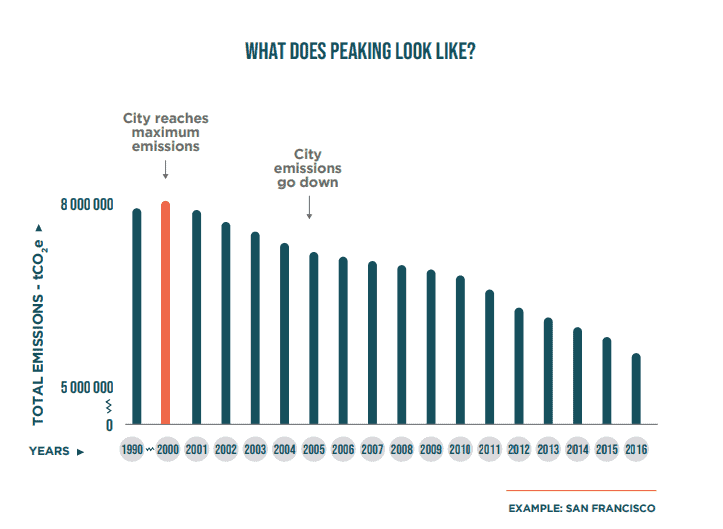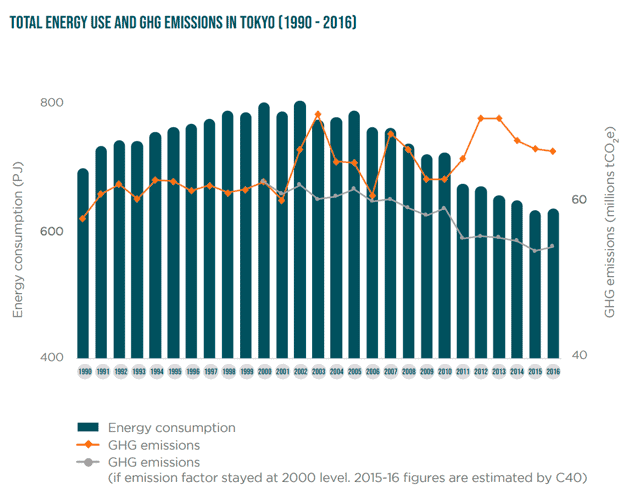Despite the lack of ambition of most countries, cities are showing they can also step up and reduce their greenhouse emissions even further. A new analysis published by a coalition of cities known as C40 concluded at least 30 major cities are on the right climate track.

The latest analysis by C40 identified a group of cities across the global north that have hit their “peak” emissions before 2015, meaning they have since reduced their greenhouse gas emissions by at least 10%. The list includes large cities such as Lisbon, Berlin, and Barcelona.
The 30 cities identified by C40 have curbed emissions by 22% on average. Some of the most significant reductions came from London, Berlin, and Madrid, which averaged around 30% reductions, while Copenhagen lowered emissions by a dramatic 61%.

Copenhagen expanded its district heating system, which channels waste heat from electricity production through the pipes into homes to meet the demands of an increasing population. At the same time, it invested heavily in its biking infrastructure and public transit.
“The key thing is that Copenhagen just shows that it is possible to rapidly decarbonize over a short period of time,” said Michael Doust, C40’s program director of measure and planning. “And the innovations they are applying are applicable globally.”
Tokyo was the only non-Western city on the list and had fluctuations in its yearly emission levels. They began falling after 2003, but by 2010 levels rose again, reaching near-peak levels by 2012 and 2013. Yet Doust assures us that Tokyo is an example of a unique success story; emissions began falling again in 2014.

Despite the success, any of the 30 cities could once again see emissions rise beyond its highest levels in the future. So far, none has, and to ensure that there aren’t any “false” peaks in their data, researchers put in that 10 percent reduction threshold as a requirement.
“It is expected that these cities should peak before 2020, and the fact that they’re doing so is encouraging,” Doust said. “You can still grow your economy; you can still grow your cities in size and still peak.”
The 30 cities are: Athens, Austin, Barcelona, Berlin, Boston, Chicago, Copenhagen, Heidelberg, Lisbon, London, Los Angeles, Madrid, Melbourne, Milan, Montréal, New Orleans, New York City, Oslo, Paris, Philadelphia, Portland, Rome, San Francisco, Stockholm, Sydney, Toronto, Vancouver, Venice, Warsaw, and Washington, D.C.
Cities and climate change

Cities are major contributors to climate change. According to UN-Habitat, cities consume 78% of the world’s energy and produce more than 60% of greenhouse gas emissions. Yet, they account for less than 2% of the Earth’s surface.
An added challenge is the projection that another 2.5 billion people will reside in urban areas by 2050. The good news is that cities around the world have already begun to take measures to reduce greenhouse gas emissions and are putting policies in place that encourage the use of alternative energy sources.
However, cities also hold the key to solving climate change. That is where most of the world’s innovation takes place, and as more and more people flock to urban areas, managing cities properly will ensure not only improved living standards, but also reduced emissions. Simply put, if we want to start tackling climate change, we need more leadership from cities — and this is exactly what we are seeing with C40.
The effects of climate change are worse among poor and low-income communities, in part because many live on the margins of society, in unstable structures, and in areas more susceptible to flooding, landslides, earthquakes, but also because of inadequate capacities, inadequate resources and reduced access to emergency response systems.
The C40 initiative actually has 90 participating member cities across seven geographic regions, from all of the world’s continents except for Antarctica.


